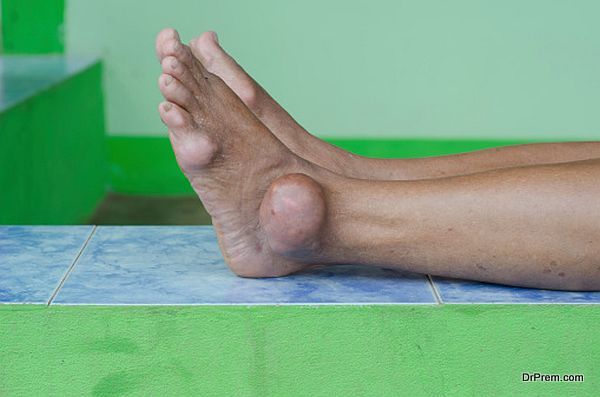Gout is a form of inflammatory arthritis that is known to affect the body’s joints and musculoskeletal system. The condition usually affects the area near the base of the big toe in the foot in which case it is referred to as podagra. Although known to affect a lot of men, women are more prone to get gout after menopause. Nevertheless, gout can be a rather painful condition to handle for both men and women and needs to be handled properly for relief.
Common Causes for Gout
The most common cause for gout is attributed to high levels of uric acid in the bloodstream. In normal cases, uric acid derived from the purines in certain foods like poultry, seafood and meat, etc. dissolves into the blood, following which it is removed from the body via urination. The buildup of excess uric acid can lead to the formation of sharp, needle like crystals that accumulate near the joints, causing severe inflammation and pain in these areas.
Risk Factors Associated with Gout
There are several risk factors associated with gout in both men and women. Some of these include obesity, old age, alcohol consumption, high purine diet, lead exposure, kidney problems, hypertension, hypothyroidism, diabetes, genetics and medications like diuretics and salicylate based drugs.
Common Symptoms of Gout
The most common symptom of gout is increased inflammation and pain near the base of the toe as well as the joints. Some of the other common symptoms associated with the condition include redness in the joints, warm joints, and formation of nodules called tophi beneath the skin, etc.
Tips to Manage a Gout Attack
There is no way one can expect the onset of a gout attack. These rather painful attacks can however, be managed in a more efficient manner with the help of the following tips.
- Taking Medications: A sudden gout attack can be handled effectively with immediate treatment using OTC medications like naproxen or ibuprofen. Aspirin is not advised as it can elevate the symptoms of gout instead of suppressing them.
- Icing the Joints: Applying an ice pack on the swollen joints can reduce the pain and inflammation caused by a gout attack. The ice needs to be packed in a soft cloth and applied on the affected joint for at least 30 minutes thrice a day for relief.
- Orthotics: Orthotics can help with gout related foot problems since it prevents the gout from getting irritated and worsening the problem.
- Drinking Plenty of Fluids: Drinking plenty of fluids will help flush out the excess uric acid from the system, thus reducing the symptoms of gout considerably. It is recommended that one drink at least 16 cups of water or fluids every day to keep the body hydrated during this period.
- Elevating the Affected Joints: It has been noted that raising the affected joints higher than chest level can help reduce the inflammation and pain in the joints. Lying down on the floor and keeping the joints at an elevated position for at least 30 minutes every day can be immensely helpful in reducing gout and its symptoms.
- Revamping the Menu:Individuals with gout need to stop eating foods high in purine. Some of these troublesome foods include red meat, poultry, shellfish, gravies and sweetbreads, etc. Switching to alternatives that contain lower levels of purine is advisable in order to reduce the symptoms of gout.
- Seeing the Doctor: It is best advised to get an expert opinion to ensure that the symptoms one experiences are indeed that of gout and not any other condition. Treatment for the condition is best started after a proper diagnosis.
Gout is a form of arthritis that is extremely painful. Usually affecting the joints, the condition causes redness, swelling and pain in the joints. However, it can be handled effectively with a few simple tips and natural treatment options.








